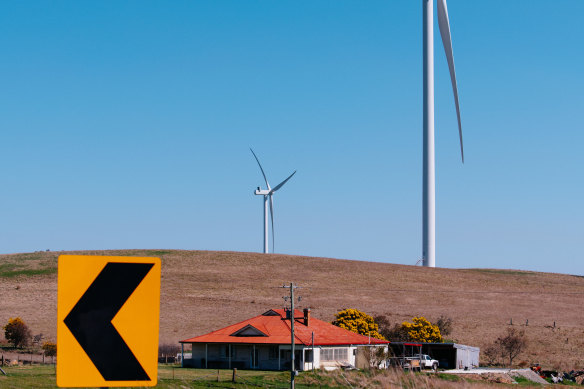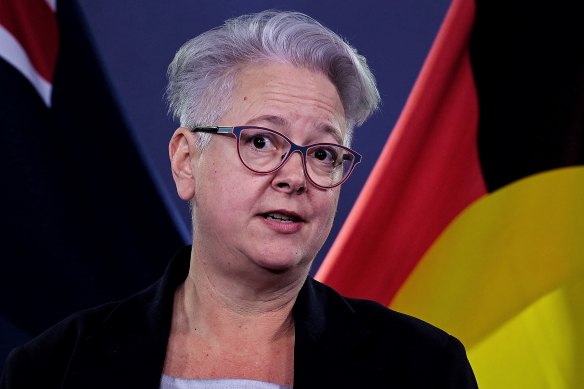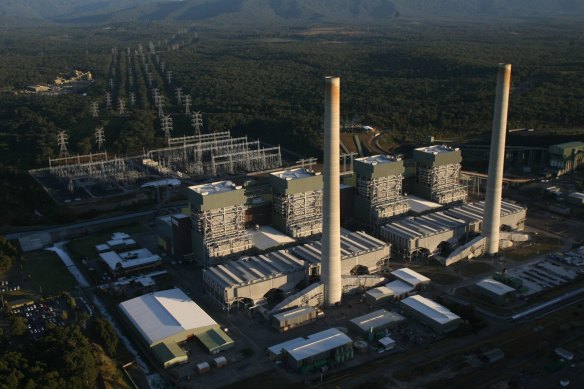This was published 7 months ago
Power play: Is one department keeping coal’s light on?
There was little surprise this week when the state government kicked open the door to using taxpayer funds to keep the nation’s largest coal power station open longer than its owners intended.
After all Penny Sharpe, the climate change and energy minister who made the announcement on Tuesday that the government would begin an “engagement” with Origin Energy over the issue had let her thinking slip as early as election night.

The Collector Wind Farm is one of the most recent to have been approved in NSW.Credit: James Brickwood
“We are hitting a cliff, we can’t have the lights go off,” said Sharpe on an ABC TV panel that night. “We are pretty annoyed by it … coming offline too early. We need industry to keep going.”
Shortly after Labor secured government she commissioned a “check-up” on forecasts for energy reliability and cost in NSW over the coming years. Unsurprisingly, when it reported this week it echoed her words from election night, saying there was a chance that by the time Origin hoped to shut Eraring in 2025 there may not be enough new renewables in place to make certain that power in the state remained cheap and plentiful.
But why not? After all, state and federal governments now back the road map plotted by former NSW energy minister Matt Kean, with the support of the then Labor opposition, to decarbonise our energy system. Renewable Energy Zones have been declared across the state in which new renewable projects are expedited. Money is flowing into the effort to build the transmission lines to link all the new power sources.
According to Sharpe, part of the answer lies simply in the size and complexity of the task at hand.
“We are basically trying to go through the Industrial Revolution in about 15 years with very complex projects on the ground,” she said on Tuesday. “We’re going from the idea that you have a few sources of energy that go into a grid that was built 50 years ago to hundreds of different sources that need new technology, that need to be connected into households. It’s a complex project. The exciting thing about this, though, is that it is absolutely doable.”
Another problem has to do with the fact that Australia is engaged in this project at the same time as the rest of the world and, as a result, there are shortages of everything from investment capital to key parts and materials to skilled labour.
These shortages have been exacerbated by US President Joe Biden’s so-called Inflation Reduction Act, which has seen around half a trillion US dollars pumped into stimulus for these sorts of projects, says Kane Thornton, chief executive of the Clean Energy Council, a renewable energy industry body. “Global competition from the IRA puts pressure on our supply chains, pressure on our workforce, all of those things make it harder and more expensive,” he says.
But research conducted by his organisations among its members shows the industry is also concerned with uncertainty about the timing of coal closures, concerns state governments might displace renewables inadvertently by propping up coal, and concerns about the speed at which new projects can be connected to the grid.

Energy Minister Penny Sharpe says NSW is trying to complete the Industrial Revolution in 15 years.Credit: Kate Geraghty
Another key problem has to do with social licence. As Sharpe says, transition involves dispersing energy production that was once centralised mostly in the Hunter Valley across the state. Objections to new solar farms, wind turbines and transmission lines from landowners across the east coast are increasing.
On the same day Sharpe made her announcement, proponents of a major wind farm in Queensland, known as Wooroora Station Wind Farm, announced the project was being cut in half to 42 turbines in response to concerns about the visual and construction impacts.
Last month Prime Minister Anthony Albanese visited Tamworth to hear farmers’ concerns about the possibility of compulsory land purchases for transmission lines after the National Farmers Federation vowed to oppose them. National Party MPs like Barnaby Joyce have ramped up a populist campaign against renewable energy.
But when you speak with proponents of new energy developments in NSW, one of the most serious stumbling blocks in the flow of clean energy that Sharpe is racing to produce is another arm of her own government, the NSW Department of Planning and Environment.

The closure of Origin Energy’s Eraring coal-fired power station may be delayed.Credit: Dean Sewell
Speaking after Sharpe’s announcement that Eraring might have to remain open, Simon Corbell, a former Labor ACT deputy chief minister and current chief executive of the Clean Energy Investor Group, said the planning system in NSW was “inherently hostile to clean energy development”.
“On the last count I saw only two new wind farms approved in NSW in the last five years. Now that is a very slow rate of approvals. And for all the good work that the NSW government did under the last government on the energy policy side of things, the NSW planning system did not respond in a similar way.
“We have a planning regime which is largely out of sync with the need for timely approvals.”
He said his members speak of being contacted by the department for critical information three years after applications had been made, essentially setting their projects back years; and of instances where projects were blocked because rural neighbours lodged development applications signalling they may one day build on adjoining land.
One senior industry figure, who did not want to be named because of the sensitivity of the debate, did not believe the system could be improved with current management in place. “The leadership within the planning department has been conditioned over a long period of time to place an overwhelming weighting on local impact over the needs of the state needs to achieve low-cost energy security for NSW and consumers,” he said.
“The department’s view is so entrenched that many renewable companies are sceptical that its senior management can ever be reformed substantially enough to manage this immense and challenging transition.”
He added that the department had not approved a wind farm since 2021, and that it changed permitting assessment guidelines without consultation or public notice.
A second senior industry figure, who did not want to be named for the same reason, said: “Its incompetence would be somewhat forgivable if it were not for the strength in their conviction that they know what is best in the face of compelling concerns communicated from those who have to deliver it.”
Asked about the industry’s concerns about planning regulations and the performance of the department, Planning Minister Paul Scully said the government inherited a renewable energy road map that was off course. “Under the previous government the NSW planning system became increasingly complex and confusing. This impacted on the delivery of the renewable energy road map.
“I’m determined to have the planning system help the renewable energy road map in NSW get back on track and the government has accepted the recommendations of the O’Reilly report with respect of planning for renewable energy infrastructure.
“I want there to be investments in solutions that secure energy supplies, keep the lights on and support job creation in NSW.”
Sharpe said that in response to the energy “check-up” published this week, the Minns government has “committed to a whole of government effort to accelerate the energy transition” that would streamline “renewables approvals in the planning system as well as enhance and coordinate community benefit sharing”.
John Grimes, chief executive of another industry body, the Smart Energy Council, said he was disappointed the NSW government was considering prolonging Eraring’s life, saying it was “conceding defeat before joining the fight” to rapidly decarbonise.
And he agreed that the NSW planning department had slowed progress.
“What we’re hearing from our members almost universally is that NSW has been a real black spot nationally in terms of getting planning approvals.”
He said at present around 100 megawatts of new renewables were being delivered each year in NSW, far short of the 2000 megawatts needed to hit the state’s renewable energy targets.
A report by Rystad Energy, a global energy consultancy, published in July found that grid scale solar and wind project approvals in Australia had fallen by 75 per cent between 2018 and 2022, in part because planning departments were asking for too much detail, were cancelling site visits and were not properly resourced to do their work in a timely fashion.
“Planning departments are often rejecting the lodgement of DAs to satisfy internal timing metrics associated with evaluating DAs ... Multiple participants commented that this was a particular problem in NSW.”
The delay in wind projects is significant in part because Australia has been so successful, so far, in installing solar. Wind provides more energy after the midday solar peak and in winter, when solar power declines, so it helps smooth supply. But all new energy sources are important, says Grimes. “We need everything, everywhere all at once.”
Get to the heart of what’s happening with climate change and the environment. Our fortnightly Environment newsletter brings you the news, the issues and the solutions. Sign up here.